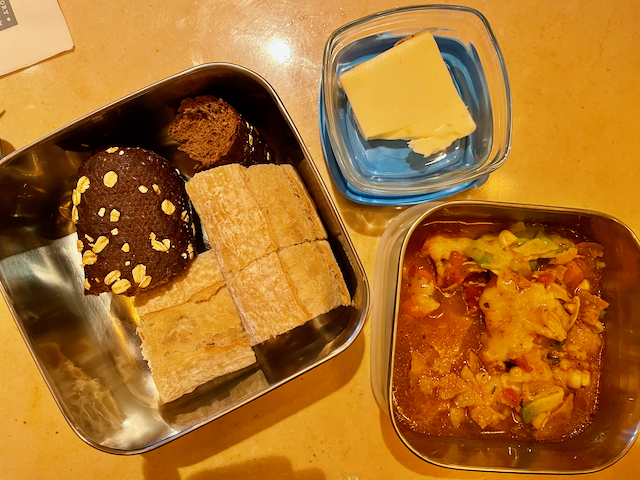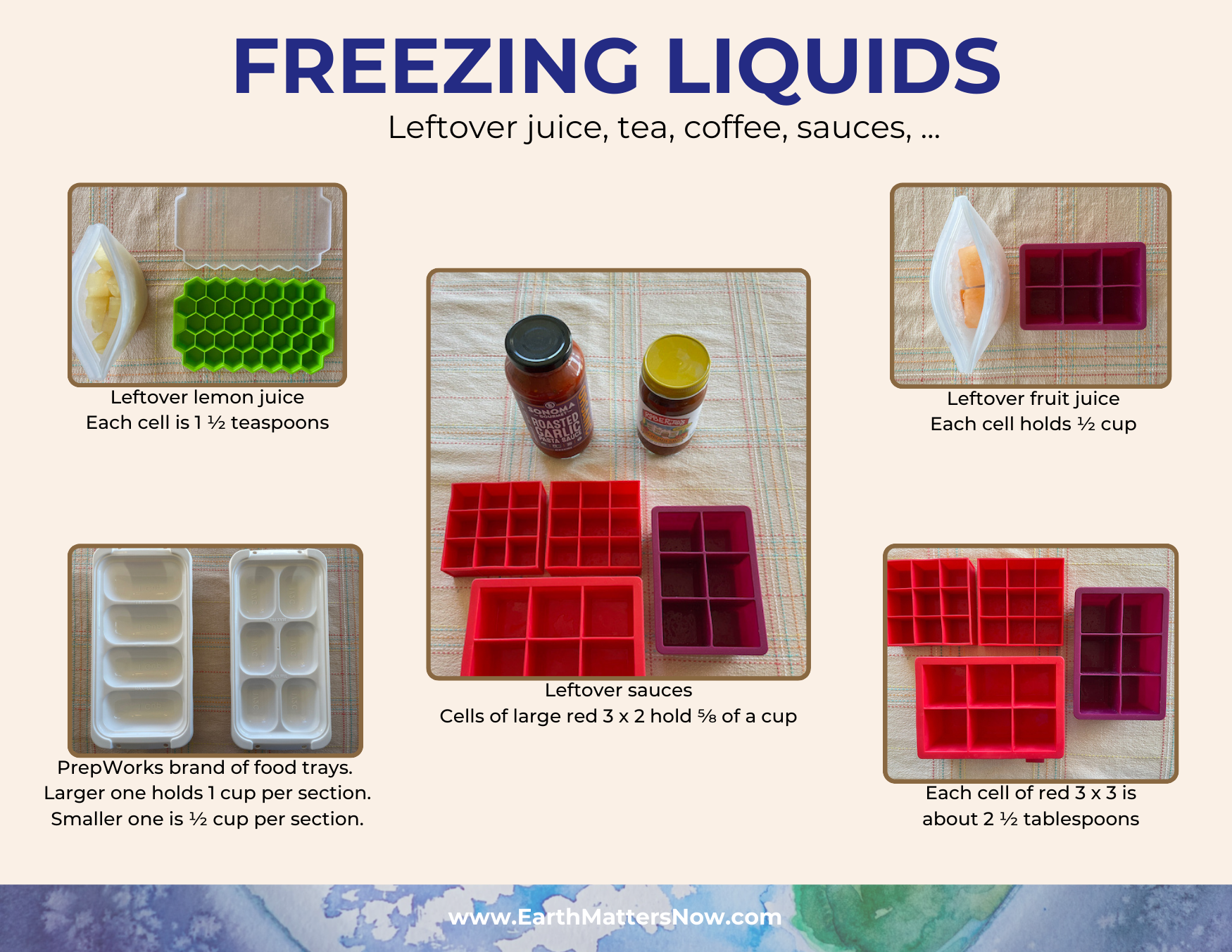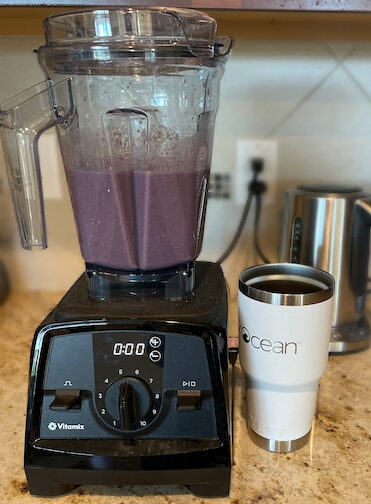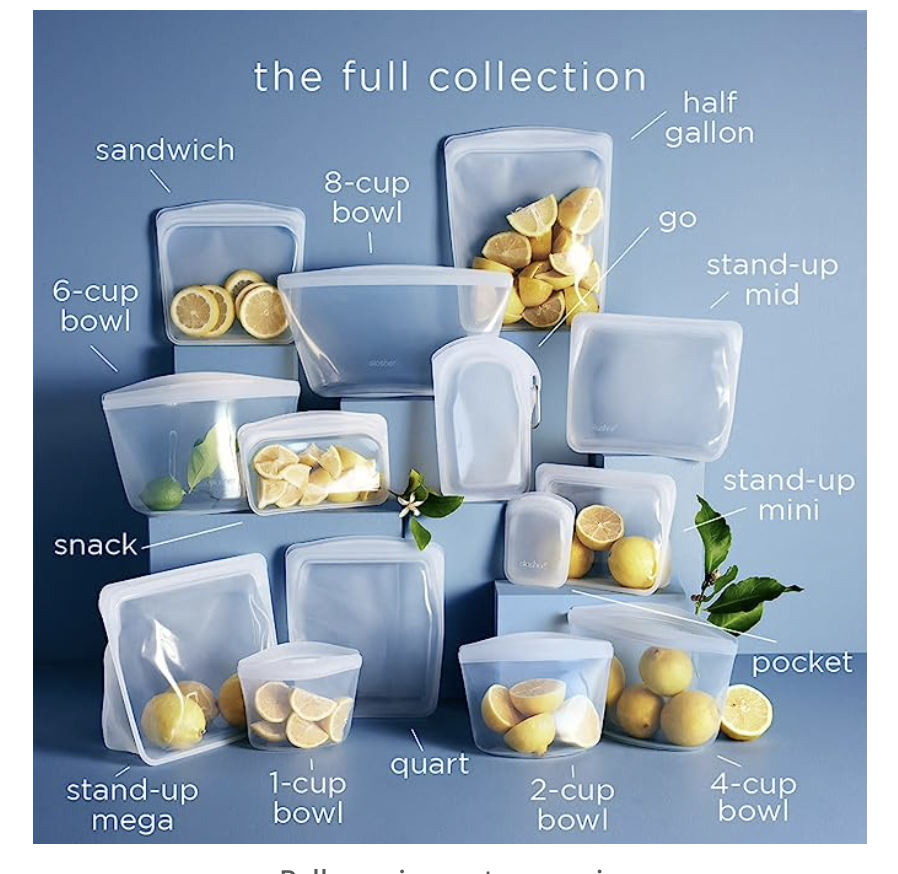Imagine that you’ve just shared an amazing restaurant meal with your family or friends. You weren’t able to finish your entree so you will be asking for a container or “doggie bag” to take the food home. Now imagine the same scenario except you have a small cloth bag hanging near your purse. Inside the bag are nested containers with lids. You package it up, taking home every last drop of deliciousness. Not only are you having food for another meal, you are not using single-use packaging to bring it home. That’s a win-win for you and the environment.


This action can become a habit if you find containers that fit your needs (size, weight, material) and then keep them somewhere in your car to remember them. [I keep mine behind the driver’s seat, which is where I store my purse.] At the end of this blog I have information about nested products that I tested out. Read on for why reducing food waste is an important step for our environment.
According to scientific research1, approximately one third of the food produced in the United States is never eaten. When food is produced but wasted, all of the water, energy, fertilizers and labor used to grow/produce the food is wasted. All the time and money used to pick, process and transport the items from farms to our tables are also wasted. To compound this waste issue, food that is put into the landfill decomposes and emits methane and carbon dioxide which contribute to greenhouse gases which are warming our planet [see side panel for more information about methane].
Different ways to reduce food waste at home
It is often hard to figure out how much food your family is going to consume in a week. I’ve read articles about menu planning, grocery lists, and other ways of keeping waste to a minimum. I know from experience that these are great ways to start, but unexpected changes happen in the course of life. Here are some of my favorite ways to deal with extra food in the house when that happens.
Leftover juice, tea, coffee and sauces

Leftover berries, spinach, kale, carrots, apples, ...
Method 1: Preserve and/or Revive
- When I purchase celery, the first thing I do is trim the tops and then rinse the outside with cold water. Then I wrap the whole bunch of celery in paper towel twice around. Next I hold this under cold water to get it damp. Then I store it in a PrepWorks container. I moisten the paper towel if it dries out. I do the same thing for my bunch of carrots. I learned this from my mom who learned it from her mom, who lived through the Depression.
- Wilted carrots, celery, herbs and some greens can be soaked in really cold water to perk them up.

Method 2: Smoothies
- I make protein shakes several times during the week. If I have leftover fruits and veggies, they will go into my smoothie. My favorite kitchen appliance is my Vitamix blender. It will turn any of these leftovers into, not only smoothies, but soups or sauces as well.
Method 3: Freeze
- Berries are easy to freeze by laying out on a cookie sheet and freezing.
- Bananas can be sliced and also laid out on a cookie sheet. The frozen slices can be mixed into oatmeal or added to smoothies. Many people make banana “ice cream” by putting frozen banana pieces in a blender for a smooth, dairy-free ice cream alternative. Yum!
- Almost any vegetable can be chopped or sliced and put into a large container covered with water and then frozen. I keep adding to this until it is full and then put the frozen block into a stock pot to make vegetable broth.
- Rotisserie chicken bones can be stored in freezer until you have several. Then add to a large pot with onion, celery and carrots (maybe frozen in water earlier) to make chicken broth.
Freezing food or leftovers for future meals
Soups, chili and stews:
I love having chicken noodle soup in the freezer for times when I’m not feeling well. I purchase a container of soup from Costco and use Souper cubes to freeze smaller batches. Or if I make a batch of chili, I leave out enough for 2 meals and then freeze the rest in the Souper cubes. Once the food in the cubes is frozen, I remove from tray and store in freezer containers. Souper cubes come in different sizes. I have the 2-cup which include lines for a 1-cup fill.
Cooked grains:
I make extra grains (oats, rice, quinoa) and freeze most of it into ½ cup or ⅓ cup servings. When I need some, I can defrost it in the microwave. Sometimes I just add a serving of frozen rice directly into my bowl of steaming hot soup.
I wanted to test different brands of food trays, so my steel cut oats in photo are in ½ cup PrepWorks freezer trays. These also come in different sizes. Overall, I find this removing cubes from this brand is easier. There is even an imprint on bottom of food cube with the amount!
The round scoops on the cookie sheet were just made with a measuring cup.

These are just some of my favorite ways to save food for future use. Be sure to post photos or other ideas below or at my EMN Facebook page. Remember that extra raffle entries (which stay in the pot for every raffle afterwards!) are given for each unique photo!
Coming next month...
Learn about how to compost food scraps. Having a good, reliable method for composting can be a gamechanger!
Details from my research for storage containers
I have purchased and used each of the products listed. I may receive a small commission if a product is purchased after clicking on the link, at no cost to you. Thank you for supporting the work at Earth Matters Now.

Container ideas for restaurant leftovers. All of the purchased containers below are made of food grade stainless steel with silicone lids and they tested to be leak-proof for me. All can go in the dishwasher.
- Reuse something from home. Weight and capacity will vary.
- U•Konserve set of three nested containers. Capacity: 5, 9 and 16 oz. Empty weight of all three = 10.7 oz
- Scoopie set of three nested containers. Capacity: ~3.5, 7 and 14 oz. Empty weight of all three = 7.2 oz
- West Bros set of three containers. Two are same size and fit side-by-side inside larger container. Capacity: 8, 8 and 28 oz. Empty weight of all three = 11.9 oz
Details from my research for freezing food
All containers (except PrepWork) are made of silicone and can go in the dishwasher.
- PrepWorks food trays available in 1/2 cup, 1 cup and 2 cup sizes.
- Souper Cubes available in 2 T, 1/2 cup, 1 cup and 2 cup. This brand also has a 1/2 oz size for breast milk.
- Hexagon cell tray. Each cube is about 1/2 oz.
- Tovolo (maroon 3 x 2 tray). This brand makes molds of many sizes and shapes.



Thank you for your information and making it easy to see the different, earth-friendly options available for carrying and storing food. In the past I have just reused containers that I have previously obtained from restaurants when taking out extra food, but I think using those made of earth friendly materials is the better choice. I like the idea of having containers of various sizes for extra sauce or to keep food separated.
I recommend containers made of earth friendly materials when purchasing new items. However, if reusing plastic containers is available, I’m all about giving things second lives. I wouldn’t use them in the microwave. My humble opinion is there is no need to purchase new if something you have already works.
Thank you for sharing, good ideas!
Great job Barbara! Good information!
I love these ideas! I have lots of Stashers but will be buying the cube trays in different sizes.
Boy, Barb, this hit home with me! I hate realizing just how much food we waste! I am going to try to put all these suggestions to use! Thanks for the suggestions!
You are most welcome!
Wow. This is all great Barb. I do some of the things you mentioned but not all. So now its on to try new things. And who said you couldn’t teach a old dog new tricks. Thank you much.
You are welcome!
Thank you, Barb. What great ideas. I especially like the suggestion of taking your own containers into restaurants for leftover food.
Thanks for the tips! I’m exited to try freezing leftover juices to make more drinks.
Wow! Thanks for the information, I will try to use all of your tips!
Love the freezing juices (lemons) with cube trays. Bringing containers for a
“doggie bag” is brilliant!
I drop a tiny lemon cube into my water bottle. So easy!
Barbara thanks for all this. Love the take home packing idea. Seldom do we need take home food but if when we do I will want to use this idea and have my own handy. To many times we buy food from the stores and then just throw the packing away – such as sour cream containers. Since we have several single men we call sons visit that are always hungry for home cooking we have started saving all sort of these containers for their meals on wheels. And sometimes they even bring them back to be reused for their next handout. LOL I already do so many of your ideas but its nice to see that others do the same and also to pat ourselves on the back once in awhile to say “Hey, we are doing a good job even if it seems small. Every bit helps”. Do love your site.